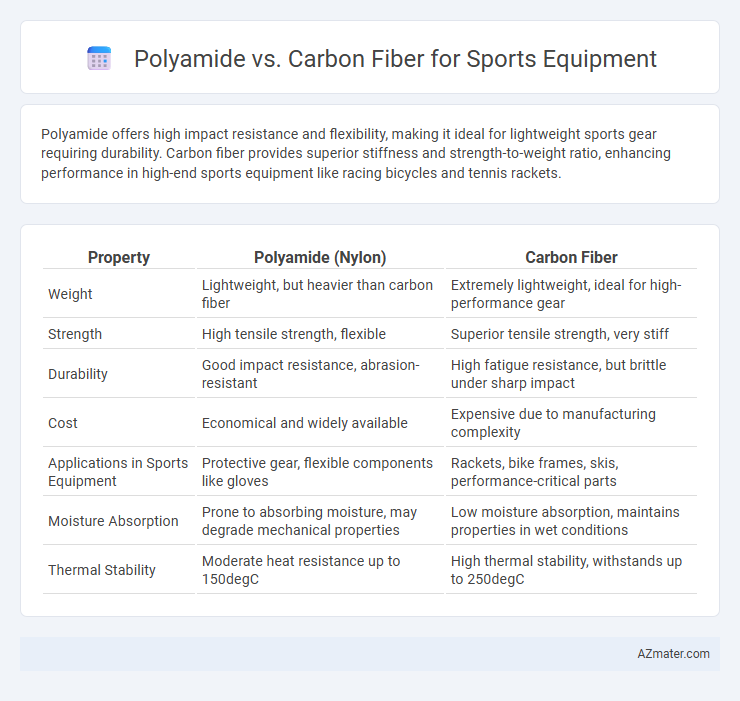Polyamide offers high impact resistance and flexibility, making it ideal for lightweight sports gear requiring durability. Carbon fiber provides superior stiffness and strength-to-weight ratio, enhancing performance in high-end sports equipment like racing bicycles and tennis rackets.
Table of Comparison
| Property | Polyamide (Nylon) | Carbon Fiber |
|---|---|---|
| Weight | Lightweight, but heavier than carbon fiber | Extremely lightweight, ideal for high-performance gear |
| Strength | High tensile strength, flexible | Superior tensile strength, very stiff |
| Durability | Good impact resistance, abrasion-resistant | High fatigue resistance, but brittle under sharp impact |
| Cost | Economical and widely available | Expensive due to manufacturing complexity |
| Applications in Sports Equipment | Protective gear, flexible components like gloves | Rackets, bike frames, skis, performance-critical parts |
| Moisture Absorption | Prone to absorbing moisture, may degrade mechanical properties | Low moisture absorption, maintains properties in wet conditions |
| Thermal Stability | Moderate heat resistance up to 150degC | High thermal stability, withstands up to 250degC |
Introduction to Polyamide and Carbon Fiber in Sports Equipment
Polyamide, commonly known as nylon, offers excellent flexibility, impact resistance, and lightweight properties, making it ideal for protective gear and apparel in sports equipment. Carbon fiber is prized for its superior strength-to-weight ratio and rigidity, enhancing performance in high-end bicycles, racquets, and helmets. Both materials contribute significantly to advanced sports technology, with polyamide providing durability and comfort, while carbon fiber delivers enhanced speed and precision.
Material Composition and Properties
Polyamide offers high flexibility, excellent impact resistance, and durability due to its polymeric structure, making it suitable for protective sports gear. Carbon fiber consists of tightly packed carbon atoms arranged in a crystalline formation, providing exceptional strength-to-weight ratio, stiffness, and fatigue resistance ideal for high-performance equipment such as racing bikes and tennis rackets. The choice between polyamide and carbon fiber depends on the desired balance between flexibility, weight, and strength specific to the sport's requirements.
Strength and Durability Comparison
Carbon fiber offers superior strength-to-weight ratio compared to polyamide, making it ideal for high-performance sports equipment requiring maximum stiffness and minimal weight. Polyamide provides excellent impact resistance and flexibility, enhancing durability in applications subjected to repeated stress and abrasion. The combination of carbon fiber's rigidity and polyamide's toughness often determines the choice based on specific sports equipment demands for strength and long-term durability.
Weight Differences and Impact on Performance
Polyamide sports equipment typically weighs more than carbon fiber options, with carbon fiber being up to 40% lighter due to its high strength-to-weight ratio. This weight difference directly affects performance by enhancing speed, agility, and endurance in sports where reduced mass can improve energy efficiency. Carbon fiber's rigidity also offers better impact resistance and durability, making it ideal for high-performance gear compared to the heavier and less stiff polyamide alternatives.
Flexibility and Shock Absorption
Polyamide sports equipment offers superior flexibility and shock absorption due to its high elasticity and impact resistance, making it ideal for activities requiring dynamic movement and cushioning. Carbon fiber, while extremely strong and lightweight, has limited flexibility and fatigue resistance, resulting in less shock absorption compared to polyamide. The choice between polyamide and carbon fiber depends on the sport's demand for flexibility and vibration dampening, with polyamide providing enhanced comfort and injury prevention.
Cost Effectiveness for Manufacturers and Consumers
Polyamide offers lower material and manufacturing costs compared to carbon fiber, making it a cost-effective choice for sports equipment manufacturers aiming to minimize production expenses. Its durability and flexibility provide manufacturers with an affordable option without significantly compromising performance, appealing to budget-conscious consumers seeking reliable gear. In contrast, carbon fiber, while offering superior strength-to-weight ratio and enhanced performance, entails higher production costs, resulting in pricier equipment primarily targeted at professional athletes and enthusiasts willing to invest in premium products.
Environmental Impact and Sustainability
Polyamide (nylon) sports equipment often involves energy-intensive production and emits greenhouse gases, yet it is recyclable and biodegradable under specific conditions. Carbon fiber offers superior strength-to-weight ratio and durability, reducing equipment replacement frequency but requires energy-heavy manufacturing and presents recycling challenges due to its composite nature. Sustainable sports equipment development emphasizes innovations in bio-based polyamides and carbon fiber recycling technologies to minimize environmental impact.
Application Examples in Popular Sports Gear
Polyamide offers flexibility and impact resistance, making it ideal for protective sports gear such as helmets, shin guards, and mouthguards in football and hockey. Carbon fiber provides superior strength-to-weight ratio and stiffness, widely used in high-performance equipment like tennis rackets, bicycle frames, and racing skis for enhanced durability and precision. Sports manufacturers often combine polyamide with carbon fiber composites to optimize gear performance, balancing flexibility and rigidity in products like lightweight protective gloves and aerodynamic bike components.
Maintenance and Longevity
Polyamide sports equipment requires regular cleaning and careful avoidance of prolonged UV exposure to prevent material degradation, whereas carbon fiber offers superior resistance to environmental factors and demanding conditions with minimal maintenance. Carbon fiber's high strength-to-weight ratio contributes to longer lifespan and better durability in high-performance sports gear compared to polyamide, which may weaken or deform over time under stress. Choosing carbon fiber results in reduced upkeep costs and enhanced reliability for athletes seeking long-lasting sports equipment.
Choosing the Right Material for Your Sports Needs
Polyamide offers excellent flexibility, impact resistance, and cost-effectiveness, making it ideal for sports equipment requiring durability and comfort, such as protective gear and footwear. Carbon fiber excels in high strength-to-weight ratio and stiffness, perfect for performance-driven sports gear like racing bicycles, tennis rackets, and golf clubs where weight reduction and rigidity enhance athletic performance. Selecting between polyamide and carbon fiber depends on balancing factors like desired equipment flexibility, weight, durability, and budget constraints to optimize sports performance and safety.

Infographic: Polyamide vs Carbon fiber for Sports equipment
 azmater.com
azmater.com